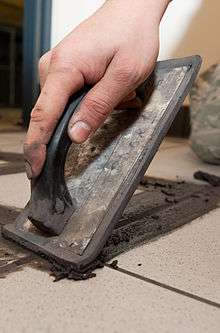Grout

Grout is a particularly fluid form of concrete[1] used to fill gaps. It is used in construction to embed rebars in masonry walls, connect sections of pre-cast concrete, fill voids, and seal joints such as those between tiles. Grout is generally a mixture of water, cement, sand, often color tint, and sometimes fine gravel (if it is being used to fill large spaces such as the cores of concrete blocks). Unlike other structural pastes such as plaster or joint compound, correctly-mixed and -applied grout forms a waterproof seal.
Although both are applied as a thick emulsion and harden over time, grout is distinguished from its close relative mortar[2] by its viscosity; grout is thin so it flows readily into gaps, while mortar is thick enough to support not only its own weight, but also that of masonry placed on top of it.[1]
Varieties
Grout varieties include tiling grout, flooring grout, resin grout, non-shrink grout, structural grout and thixotropic grout.
Tiling grout is often used to fill the spaces between tiles or mosaics, and to secure tile to its base. Although ungrouted mosaics do exist, most have grout between the tesserae. Tiling grout is also cement-based, and comes in sanded as well as unsanded varieties. The sanded variety contains finely ground silica sand; unsanded is finer and produces a non-gritty final surface. They are often enhanced with polymers and/ or latex.
Structural grout is often used in reinforced masonry to fill voids in masonry housing reinforcing steel, securing the steel in place and bonding it to the masonry.[2] Non-shrink grout is used beneath metal bearing plates to ensure a consistent bearing surface between the plate and its substrate.
Portland cement is the most common cementing agent in grout, but urethane- and epoxy-based formulas are also popular.
Portland cement-based grouts come in different varieties depending on the particle size of the ground clinker used to make the cement, with a standard size of around 15 microns, microfine at around 6–10 microns, and ultrafine below 5 microns. Finer particle sizes let the grout penetrate more deeply into a fissure.[3] Because these grouts depend on the presence of sand for their basic strength, they are often somewhat gritty when finally cured and hardened.
Tools associated with groutwork include:
- grout saw or grout scraper a manual tool for removal of old and discolored grout. The blade is usually composed of tungsten carbide.
- grout float a trowel-like tool for smoothing the surface of a grout line, typically made of rubber or soft plastic.
- grout sealer a water-based or solvent-based sealant applied over dried grout that resists water, oil, and acid-based contaminants.
- Dremel grout attachment an attachment guide used in a die grinder for faster removal of old grout than a standard grout saw.
- pointing Trowel Used for applying grout in flagstone, and other stone works.
See also
References
| Wikimedia Commons has media related to Grouting. |
- 1 2 "Not mortar, not concrete—grout!". Masonry Advisory Council. 28 April 2015. Retrieved 2015-09-13.
- 1 2 Beall, Christine (1987). Masonry Design and Detailing for Architects, Engineers and Builders. McGraw-Hill. p. 103. ISBN 0-07-004223-3.
- ↑ Babcock, Britt N., Cement grout vs. chemical grout, avantigrout.com